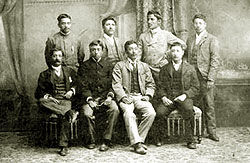 Among other Rana rulers of his period, Deb Shumshere was a reformer and was impressed by Japan's Meiji Reformation and the rapid strides that the country was taking in science and technology. He looked at Japan as a role model and initiated education reforms in the country in 1901.
Among other Rana rulers of his period, Deb Shumshere was a reformer and was impressed by Japan's Meiji Reformation and the rapid strides that the country was taking in science and technology. He looked at Japan as a role model and initiated education reforms in the country in 1901. As part of a strategy to reduce dependence on the British in India, he also seemed to have decided to cultivate closer ties with Japan. The first outcome of this decision was the departure of eight Nepali students for higher studies in Japan more than 100 years ago (see pic, top). The strategy was what is today known as \'technology transfer\', and Nepali rulers decided on the subjects that they felt the country needed: armaments, horticulture, engineering and mining.
At this time, Japan was in the process of reform: the Tokugawa era had ended and power was restored to Emperor Meiji in 1868. Reform work was carried out in education, law, transportation, communication, commerce and Western-style industrialisation had started. Then in 1899, the Japanese Zen ascetic, Ekai Kawaguchi, became the first Japanese to live and travel extensively in Nepal. He initially entered Nepal illegally (since the country was closed to foreigners at that time), masquerading as a Chinese monk on his way to Tibet. This lead to suspicions that he was actually a Japanese spy. However, historical records in his birthplace, Sakai, show that he was indeed a Buddhist monk with a keen interest in collecting Tibetan Buddhist scriptures and Sanskirt manuscripts.
Kawaguchi stayed for nearly a year at Tukuche, Marpha and Chharang and brushed up on Tibetan which he had studied in Darjeeling. During his stay, he sought to secretly travel to Tibet and ultimately succeeded in doing so through Dolpo in July, 1900. His book Three years in Tibet, published in Madras in 1909, narrated his travels.
According to the different books on Japan-Nepal relations, Kawaguchi liked Nepal so much that he suggested to the Rana rulers that more effort should be made in education for development. It was on his suggestion that Nepali students were sent to Japan.
The scholarships materialised during the rule of Prime Minister Chandra Shumshere. Eight students, 17 cooks and attendants and a guide from India, Swami Giri, were sent to Japan. Leaving Nepal on March 1902, the students boarded a ship in Bombay on 29 April 1902 for their 46 day journey to Yokohama with stops in Colombo, Rangoon, Singapore, Hong Kong and Kobe.
Arrangements for schooling was requested from the British legation in Tokyo by the Nepal government and students were admitted to three government institutions: Tokyo Teikoku Daigaku (presently Tokyo University, Department of Technology), Tokyo Kogyo Gakko (presently Tokyo Institute of Technology) and Noka Daigaku (presently Tokyo University, Department of Agriculture) and were officially called the 'State Students of Nepal'.
The students were aged 18-27 and they had interpreters to overcome their language barrier. Among them were Jang Narsingh Rana and Bhakta Bahadur Basnet studying ammunition engineering, Deb Narsingh Rana and Bal Narsingh Raimajhi in mining, Deep Narsingh Rana in agriculture, Hem Bahadur Rajbhandari in mechanical engineering, Rudra Lal Singh in applied chemistry and Bichar Man Singh in ceramics.
The students lived in a large house and because of their high caste, some had their own cooks and attendants. By all accounts, the Nepali students were diligent and worked hard. They returned to Nepal in 1905 and were immeidately given jobs to put what they learnt to good use.
Students who studied ammunition and mining were employed to develop the Howzer mountain gun, three-pound gun, and worked to modernise Nepal's arsenals. Deep Narsingh who studied agriculture planted the first Japanese flowers and fruits, wisteria, chrysanthemum, persimmon and chestnut, which have now almost become native to Nepal. Another student was appointed to Saptari for the construction of the Chandra Nahar, Nepal's first irrigation canal. Bal Narsingh Raimajhi minted the one paisa and five paisa coins at the request of Chandra Shumshere.
Although they were enthusiastic about developing the country, some Rana rulers became suspicious that the students had been infected by the \'democracy bug\' while in Japan. They started to talk about democracy, development and even about the ability to make grenades with with which to attack government offices! Most were subsequently transferred out of Kathmandu. Some were even exiled.
The seeds that were planted then by Kawaguchi, Deb Shumshere and the eight pioneering students is now being carried forward by more than 200 Nepali students studying in Japan. The Nepali Students' Association in Japan (NESAJ) has 138 registered student members today: 22 enrolled as undergraduates, 52 in masters programs and 64 in PhD courses.
Kumar Basnet is a PhD student at Tokyo's Sophia University, and president of the Nepali Students' Association in Japan. He wrote this piece on the occasion of Japan's National Day, 23 December.


